#15th century kirtle
Text
Things I made in 2023
I feel like I have made a lot of stuff last year, so I want to share. Everything is 100% hand sewn because I hate sewing machines, and I also make my own patterns

this 1480s jacket (most of that I made in 2022, but I finished it in 2023. Based on a few jackets seen in German art, detailed making of post in the pinned post
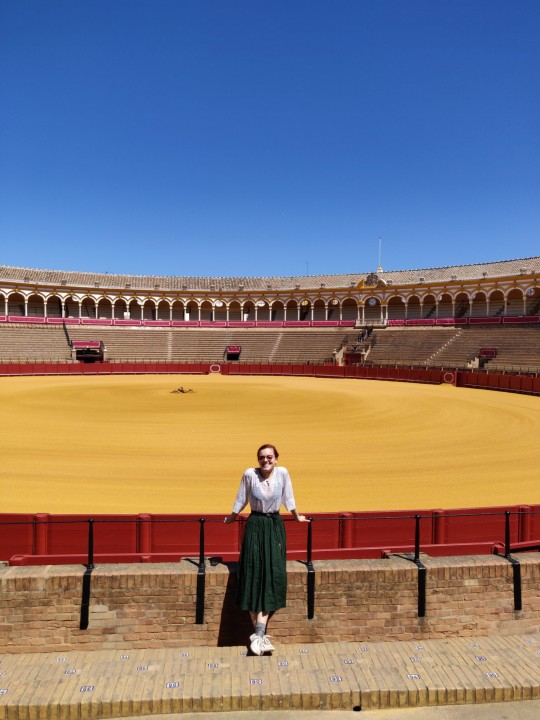
i dont have a good pic i realised, but this blouse that I made from an old curtain with shitty equipment while visiting my parents
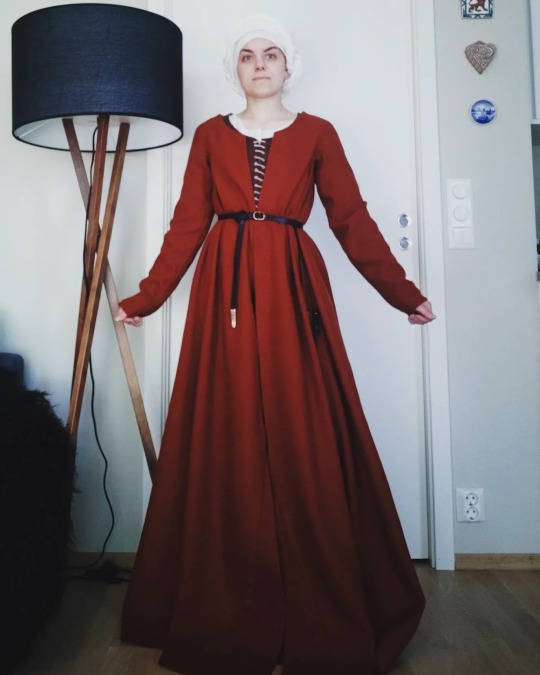
15th century gown. once again, making of post in pinned post. I feel like a wizard wearing it
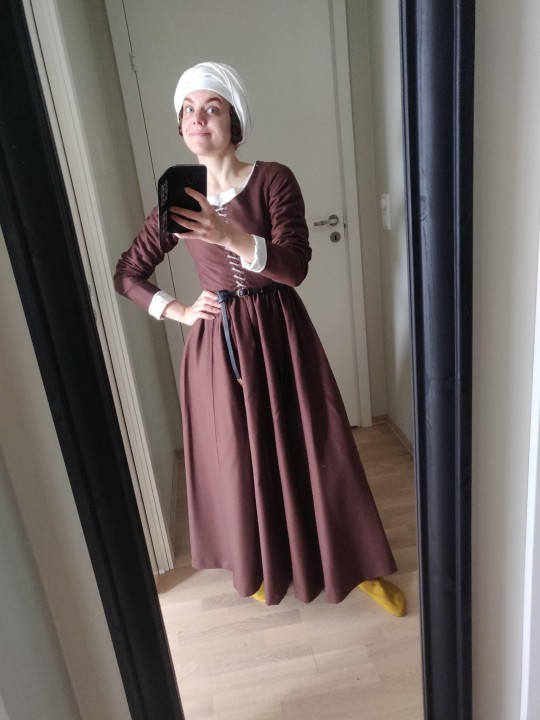
brown 15th century dress number 1. really nice thin fabric, i ripped the sleeve while setting up a tent and felt very buff. making off post in pinned post

these trousers, or breeches. not made from scratch, but made from old woollen suit trousers from my grandmother. I love them and wear them all the time and have 3 more pairs of her old trousers that I also want to make into this style
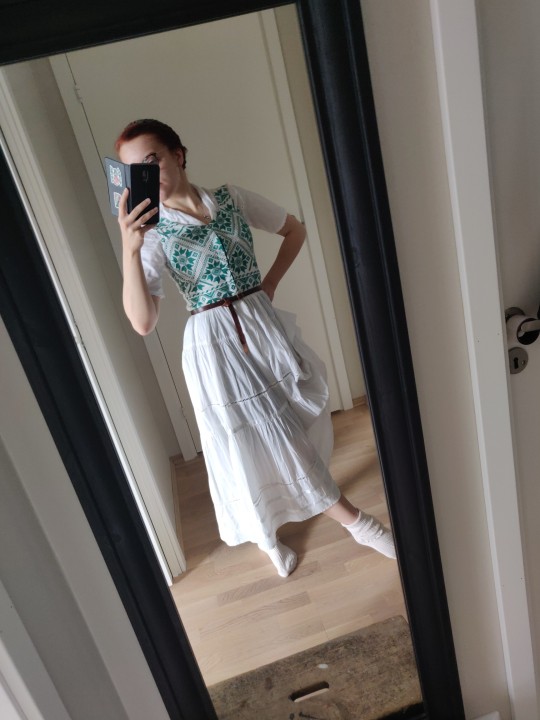
in the theme of upcycling: this dress is made of an old, hand embroidered pillow case from my grandmother (bodice), and an old skirt from my mum. perfect for summer!

brown 15th centuru dress number 2. I made this in a week, to have a working kirtle that I could quickly put on in the mornings. 10/10 i wore this the most this year i think. light fabric and wide sleeves are ideal. making of post in pinned post

medieval shift, I made two of those

wool skirt I made without measuring anything. very dark academia, I like it
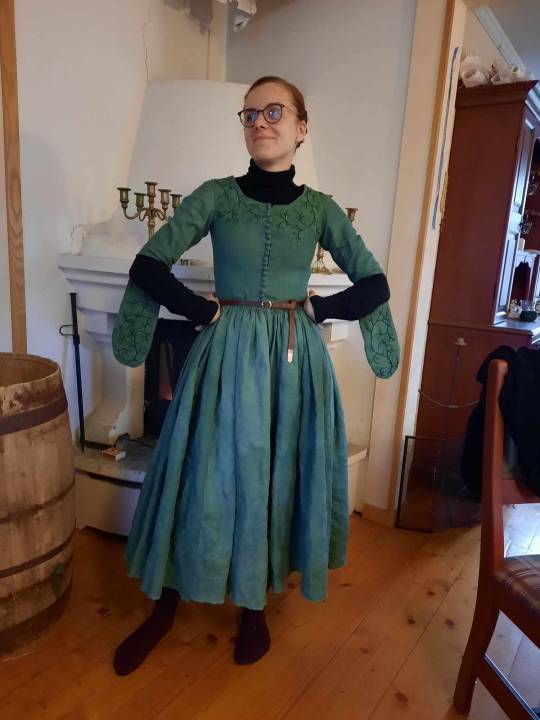
and finally, my epiphany project. dreamt this dress up on the metro and had to make it. dyed the fabric, hand embroidered it, constructed the sleeves, made fabric buttons and sewed 20 button holes by hand, just to wear it to a christmas party. i am very proud of it
I want to do more upcycling projects in 2024, as I am finishing my PhD this year and won't have time for reenactment events. So more modern stuff is in the plans! (aka stuff i will wear in every day life, idk what is modern)
75 notes
·
View notes
Text
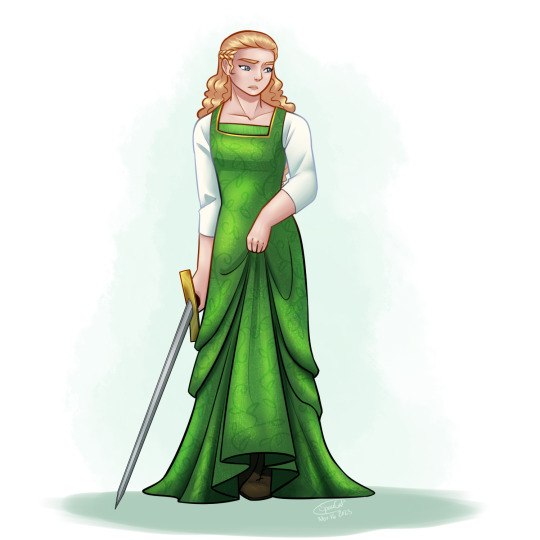
Éowyn in a nice green kirtle I saw on the priorattire youtube channel. I saw it and knew it would be perfect for her!
The kirtle in question appears at 5:36 in this video https://youtu.be/ZjsL6QTSW5I?si=6hBksQ-xHOoTErSS
[ID: a digital drawing of Éowyn from Lord of the Rings. She has pale skin and wavy blonde hair which is pulled away from her face. She is standing facing the viewer with averted eyes and a slightly concerned expression and holding a sword with its point on the ground in her right hand and the skirts of her gown in her left. Her gown is a sleeveless green 15th century kirtle with a square neckline and a very long skirt. The white, three-quarter length sleeves of her shift are also visible under it.]
59 notes
·
View notes
Text
King and his mother?!
In Christ's College Chapel, Cambridge is 16th century stained glass window, a rare example which survived nearly intact. It is thought to be done in 1505. On left is Henry VII. And the woman on right is Margaret Beaufort. In the most unexpected outfit.
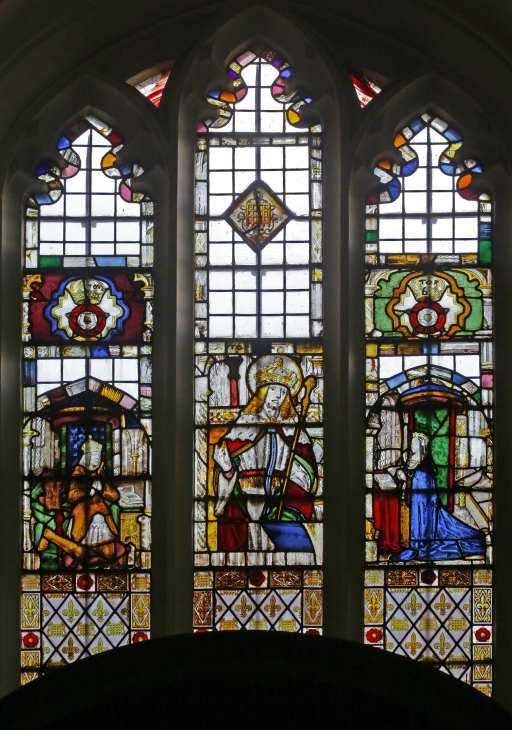
Read further for more.
In middle is St. Edward the Confessor,

on left King Henry VII wearing his armour and crown, already grey-haired.

i just love the silvery part of his armour and also these portculises.
Green behind him probably has to do with tudor colours-green and white.
But it is the female figure on right which caught my attention. It is said to be lady Margaret Beaufort, who was very involved with Christ's College in 1505. Hence it is very logical to asume it is her.

However if you play with image a little bit to see the woman's outfit a bit better...you will realise woman is dressed extremely sumptuarily.

The cloak is held in place by white rope ended by tasle-standard design for female cloak of the time. But this vivid blue colour could be one of blues made using snails as dye...very expensive, on par with purple. The pillow beneath her feet is in same colour, cloth before hr crimson-also very expensive.
So what is the golden part? Her gown+wide sleeves of that gown.
Her headwear seems to be plain black, but otherwise it is pure sumptuousness...not at all what we would expect lady Margaret to wear.
Thus i questioned whetever or not it might be Elizabeth of York instead, however i doubt it because of the shape of coronet. It doesnt match Henry's crown and we have depictions of CoA in crown matching her husbands. Plus these wide sleeves are more consistent with 1510s, they wouldnt become part of English fashion until at least mid 1500s, after Elizabeth died. (As far as i know.)
But then Margaret and the college were in 1505, so it makes sense.
Yet I always imagined that her simple outfit we know from portraits had something to do with her swearung celibacy in 1499.
Can somebody please check records of her wardrobe? Because this is way after and she is depicted truly lavishly. But you know-she got her son on throne after years of struggles and worries. Which one of us wouldn't then want to enjoy her golden years?
You know we had similiar thing with Margaret of Austria. She had so many portraits of herself in simple outfit, looking like true mourning widow and didnt want to remarry after two dead husbands. So people mistakenly think that is all she wore all the time, even though it was not so.
Unfortunately the image is also bit dirty and scratched or worn of in places. I imagine that originally it looked more like this:

I know that at the very top we have lines consisting with white chemise, then black line which could be black kirtle, then line of large pearls(maybe ment to sit on edge of black kirtle) then golden line is probably edge of golden gown...but right under it imo is edge of ermine surcoat.

Which obviously would not be showing over lower parts of golden gown.But normally there is no band running across in middle of the chest-imo that is damage.
Then obviously her blue cloak is held in place by pieces of white rope(typical of the time)-ending in tassel.
That is how i interpret it and this is the best version i could come up with:

One more thing. I do not know which one of these is correct:
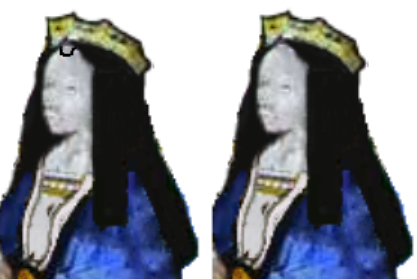
With or without u-band.
U-band on forehead occurs in gable hoods of 15th century. After 1505, the vast major women would long since have abandoned it. Like a decade prior.
Yet she was over 60, so i cannot rule out that granny who nobody would have dared to criticized-because she was mother of the king- would have gone around in something way out of fashion.
But then...she has no visible paste and that is consistent with 15th century too. Yet the gown is strongly against it.
So this is bit of contradiction, based upon just this small detail.

But who knows, maybe it is simply dirty in the most unfortunate of the spots and conicidently looks more like u-band, while it might be bit of hair showing.
I hope you have enjoyed this and tell me what you think.
27 notes
·
View notes
Note
Yo Kren
Since you're an expert enthusiast in historical fashion lend a fellow a hand.
I really wanna design renaissance characters rn, you know where I can look that up? Like a book with pictures online with lots of interesting designs for inspiration
hiya!!
okay, it's been a little bit since I've been really looking into historical fashion, but I'll do my best to help out!
first, it depends on when in the Renaissance you're looking at, as well as where, and who. the fashions differed from place-to-place, differed based on social class, and were fairly different from decade-to-decade, let alone from the beginning of the Renaissance (14th century) to the end (17th century). I'm most familiar with fashions of the English Renaissance, mostly the period of the Tudor and Elizabethan eras (late 1400s to late 1500s), so I'd mostly be able to help with things from that time period.
Fashion History Timeline is a handy website (which I may have told you about?) made by the Fashion Institute of Technology (FIT) in New York, which gives an overview of common fashions in different decades. this is where I tend to start, and look deeper into the different aspects I find interesting or are important to the construction, shape, etc. of different pieces and outfits.
From there, I tend to look at either my local library, on Google Scholar, JSTOR (which you may be able to access either through a personal account, a school library, or a public library), Project Gutenburg or the Internet Archive (those are good for older sources), or on the general internet for the aspects I may be wanting to learn more about. Generally, I look into:
the fabrics that would have been used,
the common patterns of the time,
the different garments that would have been worn (shirts/shifts, hose, tunics, jerkins, overcoats, kirtles, dresses, pockets, etc, depending on whose clothing you're looking at)
the specific layers and their order,
any techniques that may have been used in that specific time / place,
and any other things that stand out
If you are looking for specifically Tudor fashions, the Tudor Tailor is a FANTASTIC source. There are a few different Tudor Tailor books, though they can be a little hard to find, but they also have a few visual sources on their YouTube channel, which are great!
Morgan Donner also has some good sources for Medieval and Renaissance dress, which I'd also recommend looking into a bit! Samantha Bullat also has some GREAT videos and tutorials on mostly 15th-17th century dress. and there are some other tutorials and such on YouTube, which can usually be found by searching for the specific garment and period (though not always)
I hope this was at least a bit helpful. and I hope you have fun!
9 notes
·
View notes
Note
What would the nezumis masquerade get ups look like? And what about the masks?! I can’t believe an event based on the hunchback movie is coming!
This is super late. I'm so sorry. I was thinking about Glorious Masquerade outfit ideas then I got this in my inbox. So, why not combine what I've been making and use it to answer this ask.
God, I wish I could draw better. Yana's intricate design for clothes makes me lose my sanity. Btw I only had the energy to make Minako's outfits. I hope these suffice.

Character theming is everything. Minako's colour motifs are black and white and the character she's twisted from is Mickey Mouse. That's what I have to work with. Also, medieval silhouettes aren't my favourite thing in the world, and it was actually pretty hard for me to find information of French fashion during the 1480s. I had to take inspirations from Renaissance fashion instead.
Looking at various references, wide v-necks paired with squared-collar kirtles underneath were quite popular with women in the 15th century.

Then for headdresses, I was introduced to the good, the bad, and the ugly. I thought about using an escoffion, a double-horned headwear, but it just didn't sit well with my vision:

I also thought about giving Minako a tiara, but I found that it wasn't extravagant enough to go with the outfits
I drew this headwear called a beaded snood because the other headwears were not great at displaying Minako's space buns in particular. Unfortunately, I scrapped the snood because it was way too complicated to draw again. The effort was not worth it.

I ended up liking the padded roll headdress and the hennin in the end. We'll get back to that later.
I experimented with the black-and-white colour scheme at first with outfits 1 and 2. Furthermore, I decided that the dress would look better with gold accents because too much black would make it look like a funeral attire and too much white would make it look like she was the bride of a wedding.
#1 has a fur lining and I just used transparent pngs from google images to make the patterns

#2 and #3 have puffed sleeves and patterns that I drew myself. The patterns were actually moderately easy to draw despite how complex it looks. I think the silhouettes look much better because of the puffed sleeves.
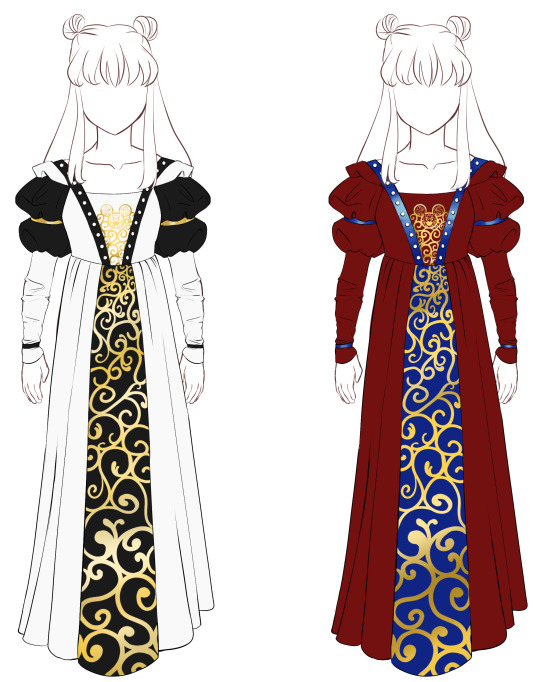
Overall, I prefer #2 and #3 more over #1.
For #2 I've decided to pair it with the padded roll (I think that's what it's called)

#3 is pretty much #2 recoloured to look like Mickey's wizard robes from Fantasia. (Is it just me, or does the gown look a little like the American flag. Red and blue are hard to pair together).
Personally, I don't enjoy dabbling with Mickey's robes as inspirations for Minako's outfits. I just don't vibe with them, but the Masquerade event gave me the perfect opportunity to try!
I've decided to pair the gown with this cone-shaped headdress is called a hennin. You've probably seen them worn by princess characters in children's media. I wanted to give the hennin a galaxy theme. I hope the stars and moon are visible enough on the veil.


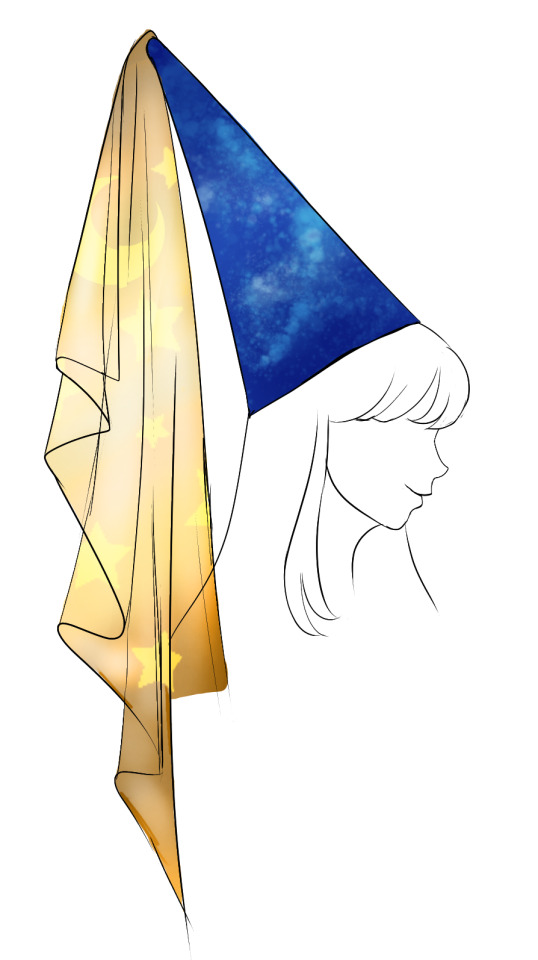
Finally, I only want one mask, and it's this:

It will be coloured soon, I swear.
I at first wanted to go for a straight animal motif mask, but that wasn't working me.
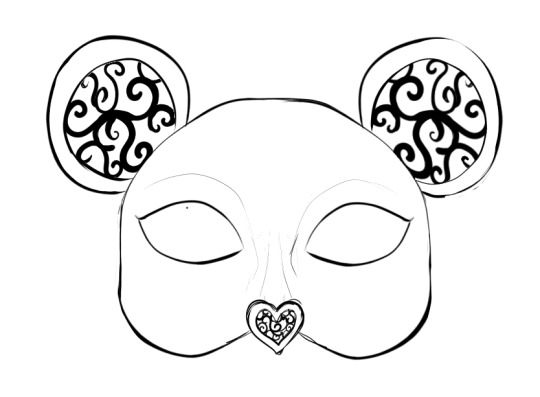
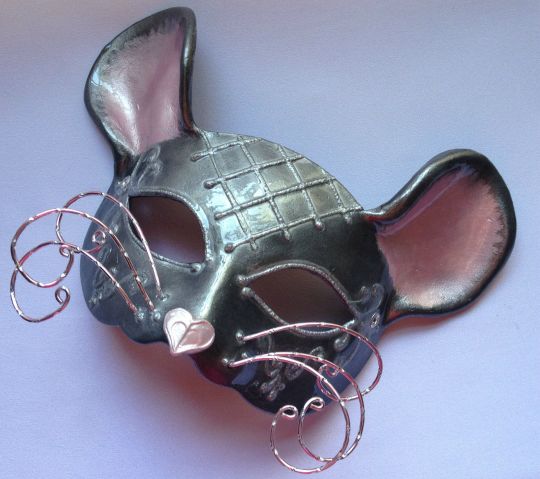
So, we're down to two, and I think they turned out pretty great. I got rid of the pearls on the v-neck not because I forgot it after through copying and pasting the same position. Ha ha ha...
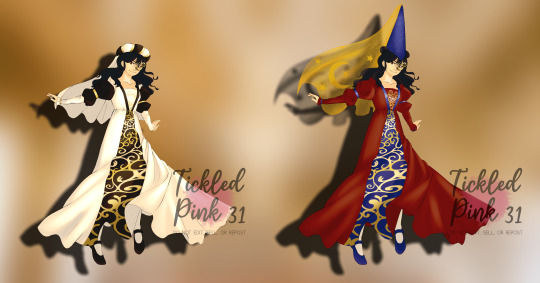
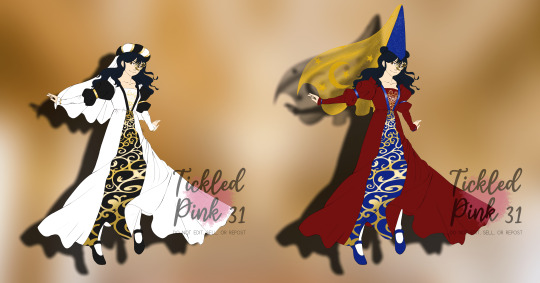
Personally, I like the black and white colour scheme more, but I'd like other people's thoughts too. What do you all think?
#ask#my art#twst masquerade#twisted wonderland x harry potter#twisted wonderland#harry potter#twisted wonderland mc#harry potter oc#oc: minako nezumi
43 notes
·
View notes
Text
Feeling really shit tonight after working hard this afternoon on drafting a late 15th century kirtle pattern and still feeling like I'm not sure if it's fitting me right, but I can't find any good tutorials or guides on how to make this style of kirtle on a plus size woman's body. 95% of the period art and modern repro/costume examples are on women who are medium or small sizes. I know what I'm aiming for in many ways, and have read plenty of articles, tutorials, and books, but I'm just not getting the result I want to see. I'm afraid that I'll never be happy with how this kirtle turns out.
6 notes
·
View notes
Text
Historical Jedi Cosplay Part 3
Ok! After analyzing SEVERAL lady jedi's costumes, I'm ready for the part where I collect real-life historical eras that I think are prime territory for a Jedi costume.
(This will be focused on Western/European fashion because that is what I know best. I would like to acknowledge that much of the inspiration for the Jedi look came from East Asian cultures, especially Japanese historical/traditional dress, because one of Lucas' biggest influences was Kurosawa and other Japanese filmmakers of the time, and the Jedi were heavily inspired by both Samurai and monks.)
The first era that jumped to mind was the late Middle Ages, because most Jedi wear some kind of tunic and tabard.The use of "tabard" to describe that extra stole kind of thingy that goes on over the shoulders is not super accurate- I believe it was inspired by the Japanese kataginu, which had various forms but was part of the formal garb of samurai and courtiers:

Source
The more formal version had these funky shoulders:
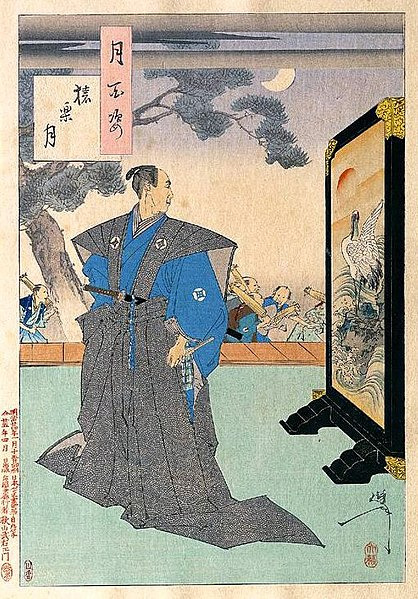
source
By contrast, most medieval tabards went fully across the chest and sometimes split into two panels below the waist for ease of riding a horse. Here are some solid ones, almost more like ponchos:

source
Here are some that are more accurately described as surcoats, because they were worn over the armor. But you can see the split below the waist.
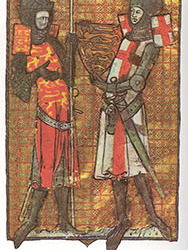
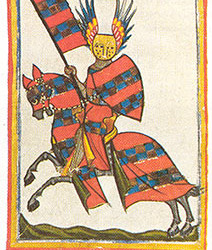
source
You also have the gambeson, which went under your armor and was padded to protect you from all that steel, or as its own protective layer. Sometimes they had metal plates sewn in for extra protection. Again, split to allow for riding. I think Jedi might like these, since they would allow for protection but also range of movement.
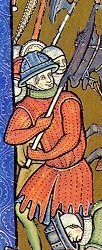
source
Of course, all these were garments worn by men, but Jedi seem to have very little gender distinction in their outfits, so I'll take it. Especially since frankly a lot of medieval outer clothing was pretty shapeless and was only gendered by who was wearing it. Here's a lady wearing sort of a tabard/cloak thing.
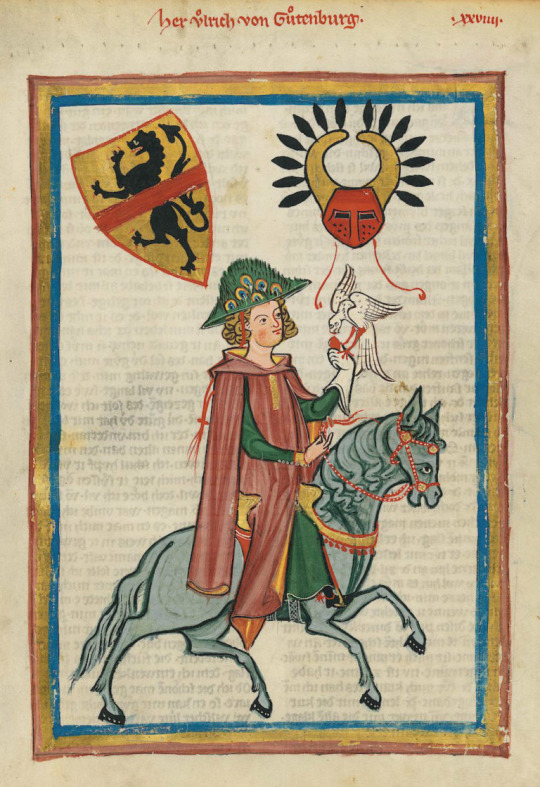
source
So for this theoretical medieval Jedi outfit, we are probably looking at about the 13th-15th centuries, and a combination of men's and women's clothing. I don't want to do armor, because on Jedi that seems reserved for active wartime combat, so at most a padded gambeson I think.
A common women's outfit consisted of a kirtle and a surcoat, like this lady:
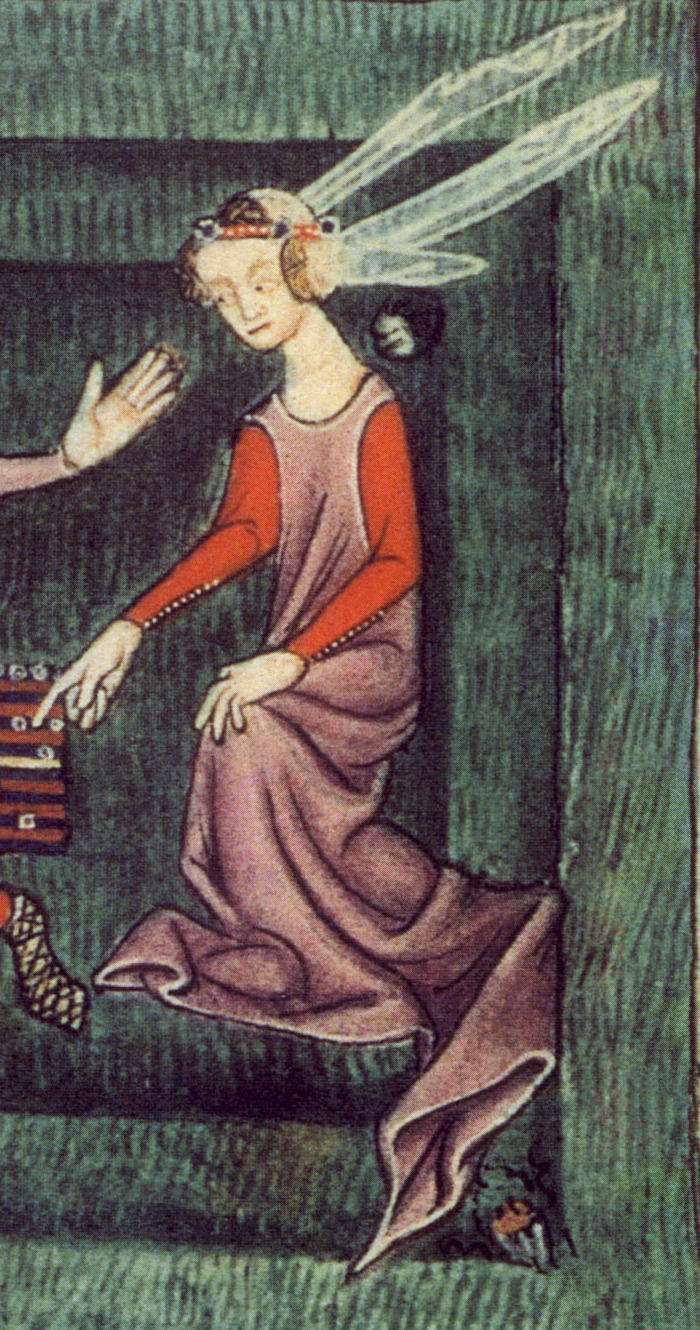
I think having the tightly buttoned sleeves would be cool.
There were a lot of Big Sleeves on overgowns and outerwear in that era too, which will be fun for the robes:
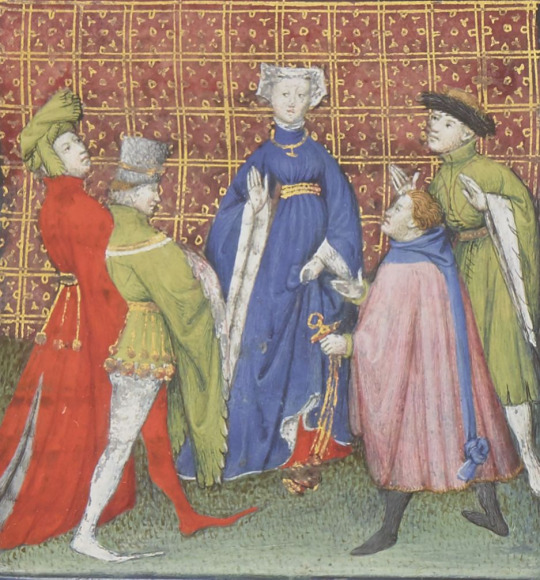
I think some heraldry would be neat to incorporate, kind of how the High Republic jedi often have the sunburst symbol incorporated into their outfits.
And of course, the hairstyle, which is where a lot of female jedi seem to express themselves, will be fun. Not sure what direction I want to go with that, but I'm thinking about how those little crespine side buns look very Leia!

0 notes
Text
why is fashion seemingly different between human and elven fashion btw? i get it for like, the dalish, having a separate style of fashion but i don't see much reason why city elves would be so different?
maybe it's a point in history where fashion is starting to change and city elves can't as quickly make the change to what? appears to be underbust stays instead of kirtles and looser tunics? but then why is elven fashion Still like that in inquisition when 10 years have passed while human fashion has moved closer to the 17th century in orlais, and back to the 15th for ferelden when they were dressing in a more 16th century style in origins?
#ama mumbles#amas dive into ferelden fashion help me#im standing in front of a board trying to figure out thedas fashion which is a foolish endeavor#why am i overthinking this. it's just generic fantasy fashion.#i know theyre meant to be corsets more than likely but i Do Not See It#another observation i had is that at least two female companions you can have over the games wear a tunic and seemingly tights#those being bethany and sera#some could also be wearing jumps too. its hard to find info on what jumps were like tho. by nature of how they were made#i figure it's a bit hard to preserve them like we have with stays and corsets
1 note
·
View note
Text
Partlet

A 16th century fashion accessory. The partlet was a sleeveless garment worn over the neck and shoulders, either worn over a dress or worn to fill in a low neckline. The earliest partlets appeared in late 15th century fashion. They were made of silk or linen, and were worn to fill in the low necklines of both men’s and women’s Burgundian dress. Early 16th century partlets were made in a variety of fabrics and colors, although black was most popular. Black partlets worn over the gown, usually in velvet or satin for the upper classes, are an earlier style. Fine partlets made of linen lawn, with standing collars and ruffles, could be worn directly over a low-necked smock, or over the kirtle. Elaborate lattice-work partlets were decorated with gold and jewels or pearls. This was called “Caulle fashion” in England.
0 notes
Photo
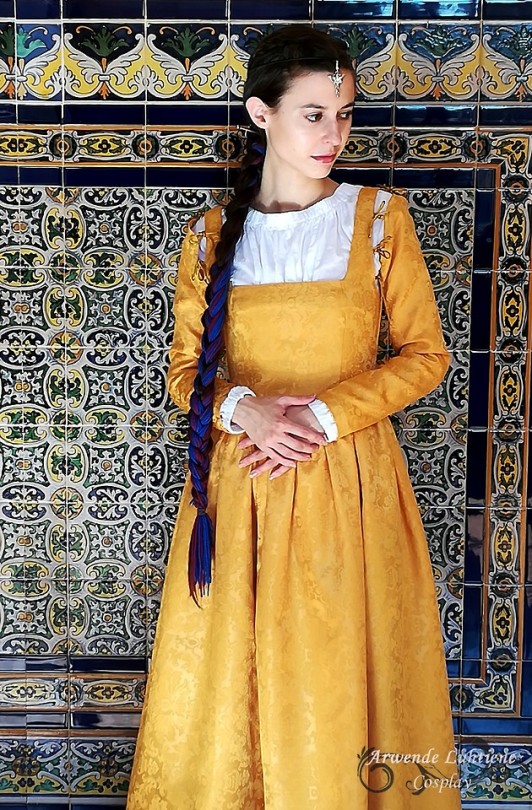
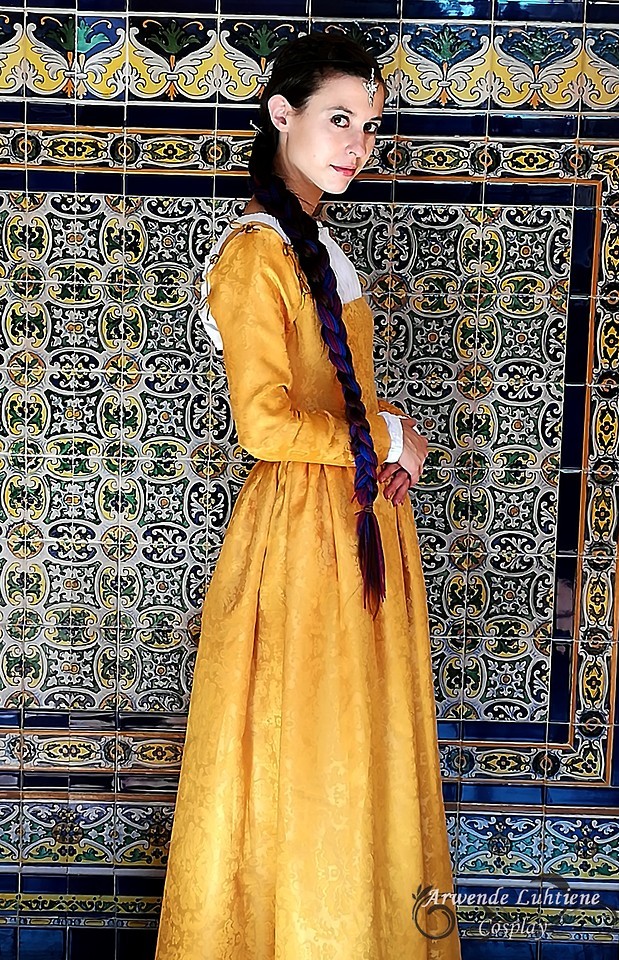

Erendis cosplay mini shoot at the 2017 EstelCon (annual convention of the Spanish Tolkien Society)
This is the late 15th Century gold yellow damask kirtle I wear under my Burgundian V-neck houppelande, also doubling as (part of) an Italian Renaissance outfit :D
Why Erendis in 15th Century kirtles? I might be heavily inspired by some of @croclock ‘s gorgeous Erendis art and now I see many Bëorian Númenóreans adopting this kind of fashion whoops xD).
I also kind of love the contrast between the bright gold yellow of this gown and Erendis’ serious, stoic and imposing character (as well as her sombre story filled with double standards and ye olde male entitlement). Erendis is one of my favourite Tolkien women and her feminist side is badass af.
My Evenstar pendants double as everything these days, from the Nauglamír to Elestirnë’s star xD
Also, how Númenórean-looking is that tile mosaic, though :D??
My 15th Century Burgundian gown/Festive fem!Gryffindor cosplay posts
My Erendis cosplay posts
DeviantArt
Facebook cosplay page
Instagram cosplay
#erendis#erendis cosplay#tolkien cosplay#15th century fashion#tolkien#unfinished tales#silmarillion#silmarillion cosplay#cosplay#My cosplays#historical#historical reenactment#My historical reenactment#15th century#burgundian#burgundian fashion#kirtle#15th century kirtle#italian renaissance#medieval fashion#medieval reenactment#numenorean fashion#numenor#numenoreans#historical costuming#middle ages
69 notes
·
View notes
Text




some beautiful details from The Seven Sacraments Altarpiece!
things of note include
- fitted short-sleeved kirtle with a waist seam and scoop neck
- some detachable sleeves
- houppelande with v-neck and gathering at the waist plus belt
- houppelande skirts lined with fur?
- pointy-toed shoes!
- head coverings pinned in place (gorgeous detail there)
- high rounded bust
The Seven Sacraments Altarpiece (1445-50) by Rogier Van der Weyden.
Sources include Wikimedia Commons here and the Web Gallery of Art here.
#these details are BEAUTIFUL#yes kirtles yes!#1440s#1450s#Van der Weyden#Seven Sacraments Altarpiece#medieval europe#technically maybe#gothic europe#15th century#historical clothing#historical fashion#netherlands
27 notes
·
View notes
Text


New Project: Late 15th century gown
I have been planning to make this for over half a year, and now it is the time!
For this I kind of follow the tutorial by the lovely Linda aka Handcrafted History, who is nice and talented and you should check out her blog if you are into reenactment!
Anyways, for this project I started out once again with my trusty kirtle pattern, which I like to use as a base for all other things because i know it fits perfectly. i traced the pattern onto another piece of cotton which i use for my patterns and then increased the armholes by adding 1cm at the shoulder and removing 2cm at the waist seam (i may need to make it even bigger, but for now it is ok).
I also changed the side and front/back seams, because as you can see these dresses are not tight fitting like the late 15th century kirtles, but very wide and then held with a belt. i have for now estimated the width, but i mat have to make it even wider
I also adjusted the sleeve to the new armholes, and made it wider as this gown should fit ontop of a kirtle


pattern making and mock up making was for this evening to be continued over the weekend when my medieval friend comes over for a sewing sunday!
the gown will be made in this lovely orange fabric

ignore the brown one for now, that is for anlther day ;)
#personal#15th century project#historical sewing#sewing adventures#15th century reenactment#medieval reenactment
79 notes
·
View notes
Photo






Historical Fashion: Kirtles
Elizabeth of York’s gown in the first episode of The White Princess is a good example of a kirtle. A kirtle is also known as a gown, cotte, tunic and it was the medieval lady’s most important piece of clothing. The particular style shown was worn during the 14th and 15th centuries. Kirtles were usually worn under the outermost gown and over the chemise/smock, but sometimes they were worn as the outermost garment. There were different styles of kirtles such as: the laced kirtle (shown in this post), the buttoned kirtle, the short-sleeved kirtle, the Mi-parti or Particolour kirtle (one half of the garment is one color and the other half is another), and the Heraldic Gown (kirtles with a family’s coat-of-arms on it). The kirtles shown are laced in front, but the laced kirtles could have laces down the side or back. [x]
#historical fashion#history of fashion#elizabeth of york#kirtles#the white princess#medieval clothing#medieval fashion#medieval dress#middle ages#14th century#15th century#1300s#1400s#art#paintings#medieval gown#historicwomendaily#ladies in history#women's historical fashion#history#medieval history#gifs: mine#edits: mine#my stuff#history-be-written#essequamvideri24#twp#clothing history
685 notes
·
View notes
Text
*plots kirtles and houppelandes because I just can't wear normal modern clothes, can I?*
#alex rambles#sewing#historical sewing#historical fashion#historical clothing#medieval clothing#high medieval clothing#renaissance clothing#14th century fashion#15th century fashion#16th century fashion#kirtle#houppelande
8 notes
·
View notes
Text
Waisted Kirtle: a challenge
In September 2017 I found a really lovely dark blue wool fabric at one of the stands at Middeleeuws Ter Apel. I immediately fell in love with it but there was a catch. There were barely two metres left of it. But I had to have it and I had to devise a way to make a dress out of it. The seller suggested I might make a sleeveless kirtle with a waist seam out of it and I agreed. So when I got home I had to device a pattern that made optimal use of the fabric. But not after I had done some research about these kinds of dresses.
The sleeveless kirtles I encountered mostly seemed to be Italian and gathered in the waist. And gathering fabric was something I could not really afford. The kirtles below seem to be less gathered and appear to have a waist seam. So these are the main images I took my inspiration from. I also decided that I would make the kirtle front laced.

Franchesco Cossa: The Triumph of Venus, (detail) 1470
Birth of John the Baptist, Meister 'G' of Turin-Milano prayer book, (detail) 1422-1424
Domenico Ghirlandaio: Birth of St John the Baptist (detail), 1486-90
Domenico Ghirlandaio: Birth of St John the Baptist (detail), 1486-90
DomenicoGhirlandaio: Announcement of Death to St Fina (detail) Circa 1474
Note that most of these kirtles appear to have a gathered or pleated skirt. I however do not have enough fabric to gather or pleat my skirt. Luckily there are examples of kirtles with a waist seam that do not appear to be pleated or gathered. Some of the dresses do show plating at the back though. They are of Flemish or Dutch origin but unfortunatly for me they usually have short or long sleeves.

Hans Memling: Passion of Christ, Greverade Altarpiece, (detail), 1470
Rogier van der Weyden, Deposition of Christ, (detail), ca. 1430-35
Hans Memling: Passion of Christ, Greverade Altarpiece, (detail), 1470
Hans Memling: St John Altarpiece, (detail), 1474-1479
Rogier van der Weyden, Seven Sacraments, (detail), 1445-1450
The fabric was a plain weave so it did not have a noticeable direction in which I should lay out the pattern pieces. This gave me a bit of freedom. I drew out the pattern on paper first and I drew another diagram to show below. The scale of the drawing is about 1:10 (the bodice pieces are not really to scale). The piece of fabric was about 190 cm long and 145 cm wide. As you can see the skirt consists of five pieces. The two pieces on the sides (the top and the bottom piece in this view) are sewn together to form a trapezoid. Once you have finished this you will have four equally big trapezoid shaped pieces. Personally I chose to have the two piece trapezoid at the front of the dress so the lacing will have a bit of space to continue lower than my natural waist.

The skirt pieces are about 110 cm long, which is long enough to create a floor length skirt. The hem circumference is about 270 cm. This worked for me but I personally find the skirt a bit on the narrow side. I yet have to cut the bodice pieces. The skirt will be left unlined but the bodice will be lined with linen. And if I happen to have enough green wool left from my other project I will make a pair of separate sleeves to go with the dress.
7 notes
·
View notes
Text

Finishing touches: red and gold leaf trim on a black wool kirtle with faux fur.
2 notes
·
View notes